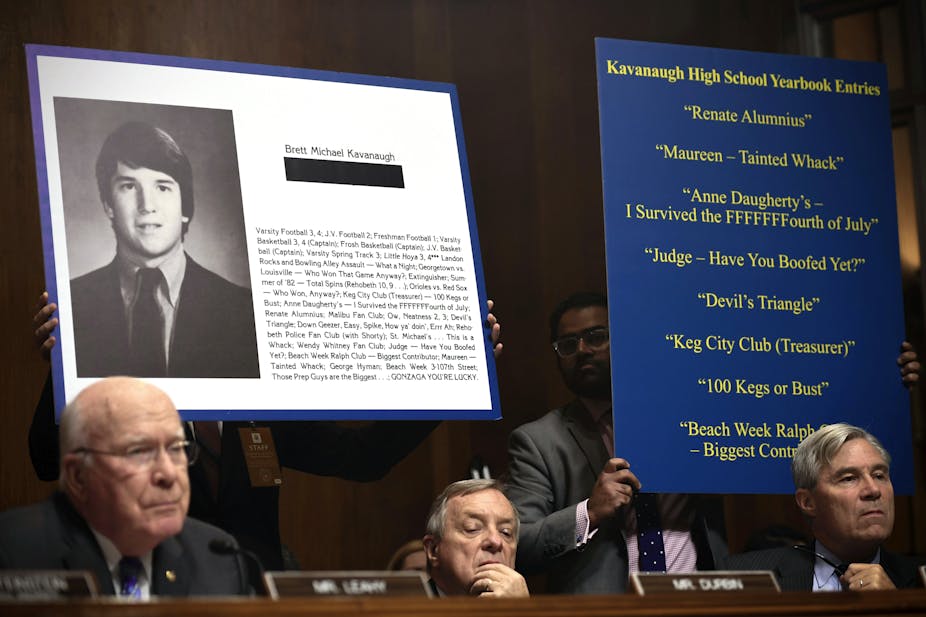Sexual assault, pushed into public conversation by the #MeToo movement, once again dominates the U.S. news cycle. Supreme Court nominee Brett Kavanaugh faces allegations that he sexually assaulted professor Christine Blasey Ford, a former high school classmate.
The allegations have led to a number of important questions regarding victim testimony, the veracity of memory and the justice system in America.
However, as social scientists who study sexuality and violence, we found ourselves asking a different question: Where were Kavanaugh and Ford’s classmates during this alleged incident?
The role of bystanders
Based on Dr. Ford’s testimony, party guests failed to notice this incident, let alone intervene to stop it. In fact, key witnesses have submitted affidavits stating that they did not see or that they have no recollection of the event. Whereas some politicians have used these affidavits to cast doubt on Dr. Ford’s allegations, we believe these affidavits are in line with research concerning bystanders’ behavior in potentially dangerous situations.
Over 50 years of research has documented a “bystander effect” in which witnesses fail to intervene in emergency situations, often because they assume someone else will take action. Recent research applying the bystander effect specifically to sexual assault has revealed that witnesses fail to intervene for a number of common reasons: They fail to notice the assault; do not believe it is their responsibility to intervene; do not believe they have the skills to intervene; or are inhibited by the belief that those around them will negatively judge them for intervening. Witnesses to sexual assault often fail to intervene for one – or a combination of – these reasons.
Under mandate of the 2013 United States Campus Sexual Violence Elimination (SaVE) Act college campuses across the United States have begun implementing bystander training programs. These programs strive to sensitize young people to the warning signs of sexual assault, like a young man leading a young woman into an isolated place, and provide them with skills so that they will know how to intervene when necessary. For example, these programs might teach young people to walk a friend home when he or she has had too much to drink, start a conversation with a young woman who appears to be uncomfortable with her date, or call the police.
Bystander training appears to help

We were curious about the effects that these bystander programs have on the behavior of young people. So in a just-published study, we analyzed data from over 6,000 college students across the United States and found that programs designed to prevent sexual assault by increasing onlookers’ interventions do have a meaningful effect on bystander behavior. Compared to peers who did not participate in a bystander program, college students who did participate reported a greater ability to intervene and greater intentions to intervene, should a situation require it.
Most importantly, those who participated in a bystander program reported actually engaging in more bystander intervention behaviors than those who did not participate in a program. On average, these participants reported two more instances of bystander intervention in the months following the bystander program than their peers who did not attend a bystander program. Simply put, bystander programs are successful at encouraging bystanders to intervene when witnessing sexual assault or its warning signs.
These findings are especially important considering that research indicates that traditional sexual assault programs, which target the behavior of potential victims or of potential perpetrators, are not particularly effective at preventing assault. Thus, the power to prevent sexual assault may lie in the hands of bystanders.
The fact that allegations of sexual assault have entered into the process of appointing a Supreme Court justice reminds us that sexual assault affects us as a community and that its prevention is a communal responsibility.
As researchers who study sexuality, violence and prosocial behavior, we believe that bystanders need to keep their eyes open and speak up on behalf of potential victims. Our research demonstrates that having been educated about bystander strategies leads to greater intervention, which should lead to fewer sexual assaults. If a vigilant bystander noticed every time a young woman was led away to an isolated place at a party, then our world would be safer for all of us. We, as a society, should strive to become better bystanders by noticing the warning signs of a potential assault, knowing strategies to intervene, and remembering that we have a collective responsibility to prevent sexual assault.

